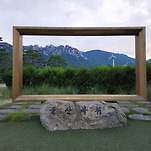|
강황과 울금은 매우 비슷한 식물로 많이 혼동되고 있으며 학명도 혼란스럽다. 아래에 인터넷을 뒤져 찾아낸 자료들에 근거하여 이 두 종을 구별한다. 우선 생강과(Zingiberaceae)에 들어가는 Curcuma 속은 전세계적으로 약 80여종이나 있어 종의 동정이 쉽지 않으나 이곳에서는 우리나라에 잘 알려진 강황과 울금에 대해서만 언급한다. 따라서 이 두 종괴 비슷한 몇 개의 종들과의 구별은 전문가의 몫으로 맡긴다. 아래 서술한 내용에 따르면 서울 창동 에서 찍은 아래 식물은 울금으로 소개되어 있지만 뿌리와 꽃이 없는 상태이기에 현재로서는 이름을 단정할 수 없다. 그러나 아래 소개한 중국식물지의 세밀화들로 보면 아래 사진 식물의 잎 모양은 울금괴 비슷한 것 같다.
국내 인터넷 사이트에는 학명이 뒤바뀌어 사용되어 있는 곳이 많다. 그렇게 된 이유는 학계에서도 이 두 종이 오랫동안 혼동되어 왔고 무엇보다도 일본에서는 지금도 이 두 종의 이름을 한자로 표기할 때 중국과 반대로 표기하기 때문이다. 일본에서 이 두 종이 학명대로 하자면 국제적 동향과는 일치되는 대로 사용되지는 모르겠디 어쨌든 우리나라에서 이 두 종의 우리나라 이름을 학명에 준거하여 제대로 부르자면 C. aromatica는 '울금'으로 C. longa는 '강황'으로 불러야 할 것이다. .
인터넷에서 검색한 세밀화는 아래와 같다 <중국식뭉지 세밀화>
강황
울금
야후 검색 세밀화 (컬러)
강황
울금
컬러 사진 출처: http://www.itmonline.org/arts/turmeri3.htm (이 사이트의 자료는 상당히 많은 자료를 검토하여 작성된 자료들이다)
참조 외국 사이트 강황 http://en.wikipedia.org/wiki/Turmeric
울금에 대한 설명 Wild turmeric has rhizomes with a peculiar fragrance and attractive deep yellow color. The rhizomes are often used in cosmetic herbal medicines and as a culinary ingredient in limited quantities as a food flavor. Leaves are broad and very decorative, elliptic with a leaf stem running as long to the tip of the blade. A fresh stalk with flowers and leaves, cut to proper size and shape, can be used as a floral indoor decoration in vase for up to 10 days.
Wild turmeric is recognised as a medical herb with strong antibiotic properties. It is believed to play a role in preventing and curing cancer in Chinese medicine 이상의 영문 설명 출처: http://en.wikipedia.org/wiki/Curcuma_aromatica
울금과 강황의 차이및 학명 문제 Curcuma aromatica is often referred to as wild turmeric and thus is often confused with the second species of the Curcuma genus, Curcuma longa, commonly known as turmeric, a popular herb used worldwide. Curcuma, however, is less pigmented than the brightly colored turmeric and is also less fragrant, which adds to confusion, given that the second part of its name is aromatica. While Curcuma aromatica and other species related to its genus may possess similar plant tops, each root material is often different in size, color and smell. However, due to similarities in name and above ground appearance, the various species of curcuma are often used interchangeably, making it more difficult to differentiate among specific uses and properties. 설명 출처: http://www.ehow.com/about_5600230_curcuma-aromatica-description.html#ixzz1Tjx5MlOP
종합 판단 이상으로 보면 다음과 같이 정리해 볼 수 있다. 강황의 지하경은 굵은 꾀경이 여러 개 달리며 뿌리는 여러 갈래로 뻗으나 뿌리에 다시 조그만 덩이는 달리지 않는다. 괴경은 향기가 갈하며 내부의 색깔은 오렌지 색 또는 짙은 황색이다. 이에 울금의 지하경은 큰 괴경이 있지만 뿌리에도 작은 괴경이 또 달리며, 향기는 엷고, 괴경 내부의 색깔은 회황색이다. 잎은 강황이 울금보다 대체로 길쭉한 편 (종소명의 longa는 '긴'이라는 뜻)이고 울금은 폭이 넓은 편으로 보이나 잎이 넓은 형태의 강황 사진들도 많이 검색되므로 확실한 특징으로 보기에는 어렵다. 꽃은 중국식물지에 나오는 설명과 http://www.itmonline.org/arts/turmeri3.htm 에서 나오는 컬러 세밀화가 서로 반대라서 어는 것이 옳은지 모르겠다. 컬러 세밀화에서는 울금의 경우에는 화관의 대부분이 붉은 빛을 띠나 강황에서는 판연의 끝 부부분만 붉은 색이고 판연의 밑 부분, 판인, 판통은 모두 흰색으로 보인다. (이상의 서술은 세밀화에 의거하였음) 꽃? 경우는 이와 같이 자료에 따라 차이가 있으므로 최종적으로 두 종의 동정을 위해서는 지하경의 특징이 가장 중요한 것으로 보인다.
국내 참조 사이트 울금 천지강산 http://blog.daum.net/w8272/12042294 강황. http://jdm0777.com/jdm/ganghwang.htm
이밖에도 국내에 이름이 나오는 Curcuma 속 식물로는 Curcuma zanthorrhiza Roxburgh, (중국명: 印尼莪? yin ni e zhu) 이 있다
|
|||||||||||||||||||||||||||
출처: wildblumenspeicher 원문보기 글쓴이: 대효










